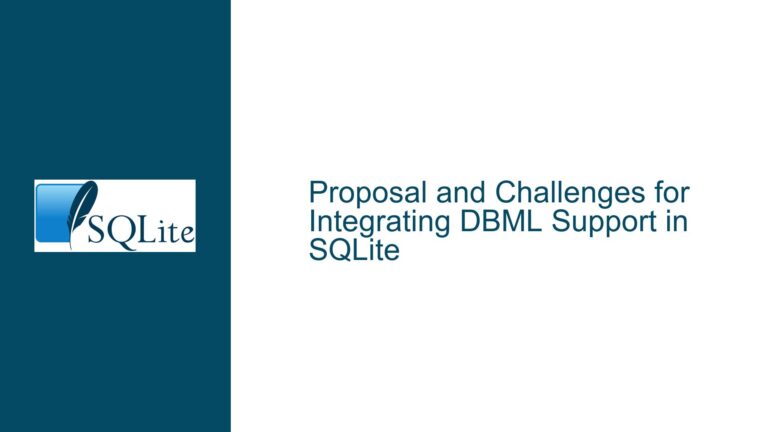Addressing SQLite’s 32-bit Page Limit and hctree’s Overflow Page Structure
SQLite’s 32-bit Page Number Constraint and Its Impact on Database Scalability
The core issue revolves around SQLite’s architectural limitation of using 32-bit page numbers, which restricts the maximum theoretical database size to approximately 17.5 TB when using the default 4 KB page size. This limitation arises from the database header format in SQLite version 3 (v3), which reserves 4 bytes for page numbers. Each page in an SQLite database is addressed by a 32-bit integer, allowing a maximum of 4,294,967,295 pages. Multiplying this by the page size (e.g., 4 KB) yields the upper bound of 17.5 TB. While this is sufficient for most applications, scenarios requiring exabyte-scale storage—such as scientific datasets, distributed systems, or large-scale IoT applications—hit an insurmountable barrier.
A common workaround involves increasing the page size via the PRAGMA page_size command. For example, setting the page size to 64 KB increases the maximum database size to 281 TB (4,294,967,295 pages × 64 KB). However, altering the page size requires executing a VACUUM operation, which rebuilds the entire database. For multi-terabyte databases, this process can take days or weeks, rendering it impractical for live systems. Furthermore, larger page sizes may degrade performance for workloads involving frequent small writes or random access due to increased I/O overhead.
The discussion also highlights the experimental hctree branch, which explores 48-bit page numbering. This extension could theoretically support databases up to 4 petabytes (with 4 KB pages) or exabytes (with larger pages). However, hctree is not bound by SQLite v3’s backward compatibility requirements, allowing structural changes such as redefining overflow page management. Overflow pages in SQLite v3 use a linked-list structure to store large BLOBs or text values exceeding a page’s capacity. While simple to implement, linked lists impose performance penalties for random access or updates, as traversing the list requires sequential I/O operations. This design forces developers to manually chunk BLOBs into smaller pieces, adding complexity to applications. The hctree branch presents an opportunity to adopt alternative structures like inode-style indexing (as seen in SQLite4) or B-tree variants for overflow pages, which would improve scalability and access patterns for large objects.
Backward Compatibility Constraints and Overflow Page Design Trade-offs
The 32-bit page number limitation in SQLite v3 is fundamentally tied to its file format specification, which has remained stable for decades to ensure backward compatibility. The database header—the first 100 bytes of an SQLite file—reserves 4 bytes for the page size and 4 bytes for the total page count. Expanding these fields would break existing tools, libraries, and applications that rely on the v3 format. For example, a database file using 48-bit page numbers would be unreadable by any standard SQLite v3 build, necessitating a major version change (e.g., SQLite v4). Such a change is unlikely, as the SQLite team prioritizes stability and universal compatibility. Even if the team pursued a v4, migrating the ecosystem would take years, given SQLite’s ubiquitous use in embedded systems, mobile apps, and browsers.
The hctree branch sidesteps these compatibility constraints by reimagining the storage layer. Its use of 48-bit page numbers is not merely an incremental change but part of a broader redesign. However, the discussion reveals a critical oversight: hctree retains SQLite v3’s linked-list approach for overflow pages. Linked lists are inefficient for large BLOBs because accessing a byte near the end of a multi-gigabyte object requires traversing all preceding overflow pages. This design mirrors the limitations of FAT32 filesystems, where fragmented files degrade performance. SQLite4 addressed this with a "segment b-tree" structure, where overflow pages are managed via an index (similar to inodes in Unix filesystems). Each segment entry points to a contiguous block of pages, enabling random access and reducing I/O operations. Adopting a similar approach in hctree would eliminate the need for manual BLOB chunking and improve performance for applications like multimedia storage or time-series databases.
Another factor is the trade-off between storage efficiency and access speed. Linked lists minimize metadata overhead but sacrifice performance. Inode-style structures require additional space for indexing but enable direct access to arbitrary offsets. For example, SQLite4’s design used a tree structure to map logical offsets to physical pages, trading marginal storage overhead for predictable access times. The hctree branch could adopt a hybrid approach, such as using linked lists for small overflow chains (e.g., <10 pages) and switching to indexed structures for larger objects. This would balance efficiency and scalability without complicating common use cases.
Mitigating Page Size Limitations and Optimizing Overflow Page Handling
Workarounds for the 32-bit Page Limit
Increase Page Size Judiciously:
UsePRAGMA page_size=65536(64 KB) before populating the database to maximize the addressable storage. Note that this must be done on a new database or after aVACUUM. For existing databases, automate the vacuuming process during maintenance windows. Monitor performance impacts: larger pages reduce fragmentation but may waste space for small rows and increase read/write amplification.Shard Databases Horizontally:
Split data across multiple SQLite files based on a key (e.g., time ranges, user IDs). For example, a logging system could use monthly databases. Attach shards dynamically usingATTACH DATABASEand query them with unified views. This approach avoids the 17.5 TB limit but complicates transactions and backups.Leverage Storage Virtualization:
Implement a middleware layer that abstracts physical SQLite files as a single logical database. Tools like Litestream or rqlite extend SQLite with replication and sharding, though they introduce external dependencies.
Enhancing hctree for Modern Workloads
Replace Linked Lists with Indexed Overflow Pages:
Modify the hctree branch to use SQLite4’s segment b-tree structure. Each overflow chain would begin with a root page containing an array of pointers to contiguous page ranges. For a 1 GB BLOB, this reduces access time from O(n) to O(log n). Developers can test this by altering thesqlite3PagerWrite()andsqlite3PagerGet()functions in the hctree source code to manage overflow segments.Add Compile-Time Configuration Flags:
Introduce options like-DSQLITE_HCTREE_48BIT_PNand-DSQLITE_HCTREE_INODE_OVERFLOWto enable 48-bit page numbers and inode-style overflow handling. This would allow downstream projects to experiment without forking the codebase.Benchmark and Optimize I/O Patterns:
Compare the performance of linked-list vs. indexed overflow structures under workloads like random BLOB updates or range queries. Use tools like sqlite3_analyzer to profile page utilization and adjust the overflow threshold dynamically.
Long-Term Strategies for the Community
Contribute to hctree’s Development:
The SQLite team welcomes patches and feedback. Developers can submit pull requests implementing inode-style overflow pages or participate in forum discussions to prioritize features.Advocate for a Standardized Extension Mechanism:
Push for a pluggable storage layer in SQLite, allowing alternative page managers (e.g., 48-bit hctree) to coexist with the v3 format. This would let applications opt into newer formats without sacrificing compatibility.Evaluate Alternative Databases for Exabyte Workloads:
While SQLite excels in embedded and single-node scenarios, distributed databases like FoundationDB or CockroachDB may be better suited for exabyte-scale systems. Use SQLite for edge nodes and aggregate data in a central columnar store like ClickHouse.
By addressing both immediate workarounds and long-term architectural improvements, developers can mitigate SQLite’s page limit constraints while influencing the evolution of experimental branches like hctree.






